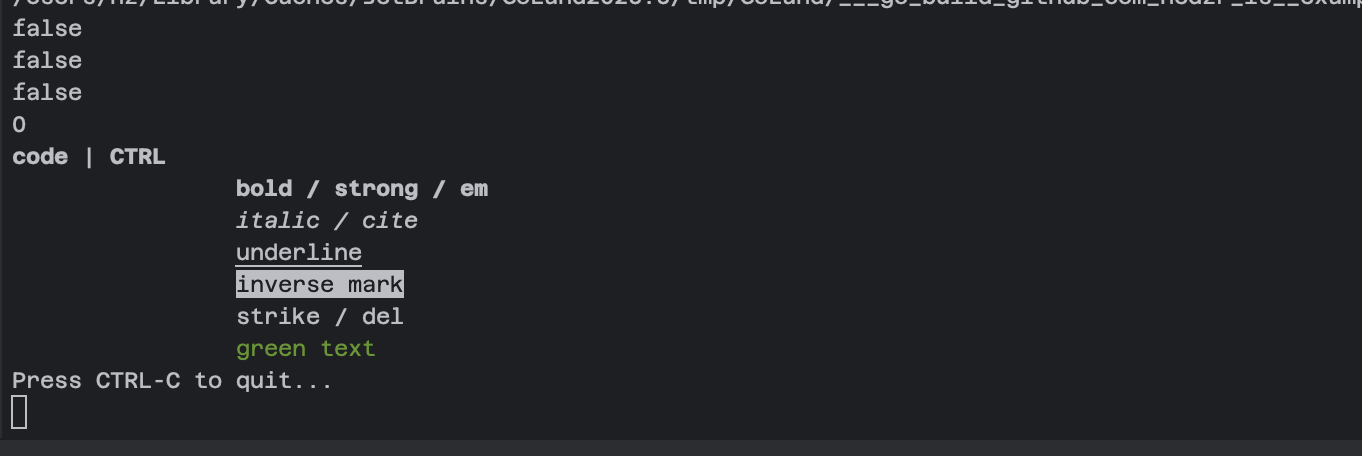Using is Detectors
is.inDeveloping()?
介绍
hedzr.is 是一个以环境检测函数为主的基础支持库。
is provides numerous detectors for checking the states of environment (build, executive, ...).
在 is 中提供了大量 Golang 运行环境检测工具,有的独立工作,有的需要配合 go build tags 协同工作。
总的来说,它们可以帮助你更好地确定当前运行环境,让你的代码能够据此进行适配。
Features
is.State(which) bool: the universal detector entry - viaRegisterStateGetter(state string, getter func() bool)to add your own ones. Since v0.5.11is.Env()holds a global struct for CLI app basic states, such as: verbose/quiet/debug/trace....DebugMode/DebugLevel,TraceMode/TraceLevel,ColorMode, ...
is.InDebugging() bool,is.InTesting() bool, andis.InTracing() bool, ....is.DebugBuild() bool.is.K8sBuild() bool,is.DockerBuild() bool, ....is.ColoredTty() bool, ....is.Color()to get an indexer for the functions in our term/color subpackage, ...- Terminal Colorizer, Detector, unescape tools.
- stringtool:
RandomStringPure, case-converters ... - basics: closable, closer, signals.
- easier
Press any key to exit...prompt:is.Signals().Catch()
- easier
- exec: Run, RunWithOutput, Sudo, ...
go1.23.7+ required since v0.7.0go 1.24.0+ required- go1.24.5 required since v0.8.55
To using environment detecting utilities better and smoother, some terminal (and stringtool, basics) tools are bundled together.
Since v0.6.0, is.InDebugging() checks if the running process' parent is dlv.
The old DebugMode and DebugBuild are still work:
InDebugging: checks this process is being debugged bydlv.DebugBuild:-tags=delveis set at building.DebugMode:--debugis specified at command line.
Since v0.8.27, basics.Signals().Catcher().WaitFor() wants ctx param passed in.
分类
基础环境
-
InDebugging: checks this process is being debugged bydlv. -
DebugBuild:-tags=delveis set at building. -
DebugMode:--debugis specified at command line. -
is.InTracing/ InTestingT -
is.InTesting/ InTestingT -
is.InDevelopingTime -
is.InVscodeTerminal -
is.InK8s -
is.InIstio -
is.InDocker/ InDockerEnvSimple -
Build (need
-tags=xx)is.K8sBuild: need-tags=k8spresentis.IstioBuild: need-tags=istiopresentis.DockerBuild: need-tags=dockerpresentis.VerboseBuild: need-tags=verbosepresentis.DebugBuild: need-tags=delvepresentbuildtags.IsBuildTagExists
States / Env
- VerboseModeEnabled
- GetVerboseLevel / SetVerboseMode / SetVerboseLevel
- QuietModeEnabled
- GetQuietLevel / SetQuietMode / SetQuietLevel
- NoColorMode
- GetNoColorLevel / SetNoColorMode / SetNoColorLevel
- DebugMode
- GetDebugLevel / SetDebugMode / SetDebugLevel
- Tracing
- TraceMode
- GetTraceLevel / SetTraceMode / SetTraceLevel
Terminal / Tty
- is.Terminal(file)
- is.TerminalFd(fd)
- is.Tty(wr)
- is.ColoredTty(wr)
- is.AnsiEscaped(s) (
IsTtyEscaped(s)) - StripEscapes(s)
- ReadPassword
- GetTtySize
- is.GetTtySizeByName(filename) (cols,rows,err)
- is.GetTtySizeByFile(file) (cols,rows,err)
- is.GetTtySizeByFd(fd) (cols,rows,err)
- StartupByDoubleClick() bool
Basics
- closers
Peripheral,Closable, Closer- RegisterClosable
- RegisterClosers
- RegisterCloseFns
is.Signals().Catcher()- is.FileExists(filepath)
- is.ToBool, StringToBool
utilities
dirsubpackageexecsubpackageterm/colorsubpackage- escaping tools: GetCPT()/GetCPTC()/GetCPTNC()
- Highlight, Dimf, Text, Dim, ToDim, ToHighlight, ToColor, ...
Usages
Result is similar with:

NOTE that is.Signals().Catch() will produce a prompt and enter a infinite loop to wait for user's keystroke pressed.
Build Tags
Some functions want special buildtags presented. These are including:
verbose: See VerboseBuild, ...delve: See DebugBuild, ...k8s: See K8sBuildistio: See IstioBuilddocker: See DockerBuild- ...
buildtags.IsBuildTagExists(tag) bool
Colorizes
The test codes:
Result:

And more:
Cursor
从 v0.8+ 开始,一个新的 color.Cursor 对象可以被 color.New() 创建,并支持用流式调用方式来完成彩色化文字。
较为完整的示例如下:
Since v0.8+, A new color.Cursor object can be initialized by color.New(), which support format the colorful text with streaming calls, for console/tty.
The examples are:
color subpackage
Package color provides a wrapped standard output device like printf but with colored enhancements.
The main types are Cursor and Translator.
Cursor allows formatting colorful text and moving cursor to another coordinate.
New will return a Cursor object.
RowsBlock is another cursor controller, which can treat the current line and following lines as a block and updating these lines repeatedly. This feature will help the progressbar writers or the continuous lines updater.
Translator is a text and tiny HTML tags translator to convert these markup text into colorful console text sequences. GetCPT can return a smart translator which translate colorful text or strip the ansi escaped sequence from result text if states.Env().IsNoColorMode() is true.
Color is an interface type to represent a terminal color object, which can be serialized to ansi escaped sequence directly by [Color.Color].
To create a Color object, there are several ways:
- by NewColor16, or use Color16 constants directly like FgBlack, BgGreen, ...
- by NewColor256 to make a 8-bit 256-colors object
- by NewColor16m to make a true-color object
- by NewControlCode or ControlCode constants
- by NewFeCode or FeCode constants
- by NewSGR or use CSIsgr constants directly like SGRdim, SGRstrike, ...
- by NewStyle to make a compounded object
- ...
As to v0.8.53, a Color object can wrap itself arroubd the given text:
与 cmdr 相集成
Closers
is 提供一个子包 closers 来抽象你的基础设施。
一个基础设施意味着一个需要在应用程序结束前实施其关闭操作的对象,可以是外部资源如数据库连接等,也可以是一个文件句柄。
在你的 app 中,可以使用 RegisterPeripheral 注册一个基础设施,并提供 defer 调用以便关闭所有这些对象。
The Closers() collects all closable objects and allow shutting down them at once.
with cmdr
cmdr 在它的工作流程中会自动执行相似的调用以便关闭已经注册的基础设施,因此 is + cmdr 可以更无缝地协同工作。
具体实施可以参考:
Signals
Signals() could catch OS signals and entering a infinite loop.
is.Signals() 能够拦截 POSIX 信号并回调你的响应函数。
For example, a tcp server could be:
WaitFor()
在 WaitFor() 回调函数体内,你可以启动你的服务。它们不必在 go routine 中被启动,而是可以直接放在 WaitFor() 回调函数体内。这是因为 Catcher() 将在一个 go routine 中运行你的回调函数。
所以对于 http server 来说,下面的做法是正确的:
假设你在其他地方启动了服务,并且通过 ctx cancel() 来管理那些服务的生存周期,那么 WaitFor 回调函数可以这么写:
当全局的 cancellable ctx 的 cancel() 函数被调用时,你的其他服务将会侦听 ctx.Done() 信号并 Shutdown,而上面的 WaitFor() 回调函数体也会结束自己,并调用 closer() 来清理 Catcher() 自身。
Howto terminate myself after a while
有时候我们可能需要提示用户等待 10 秒钟(10s)然后自动结束等待并退出程序。
这个需求可以用 Catch() 来实现:
尽管这个方案看起来稍微有些笨重繁复,但事实上并非如此,它工作起来相当轻巧,没有任何互锁机制导致迟滞。
当然,如果是单纯地需要一个简单地“Press any key to continue...”,可以使用 is.PressAnyKeyToContinue(in io.Reader, msg ...string) (input string) 或者 is.PressEnterToContinue(in io.Reader, msg ...string) (input string) 来达成目的。它们仅仅使用 bufio.Fscanf() 或者 bufio.NewReader(in).ReadBytes('\n'),一定比 Catch() 方案轻巧——除非你也同时需要对 os.Signal 进行捕俘。你应该提供 os.Stdin 作为其参数。
额外的话题
:end:
How is this guide?
Last updated on